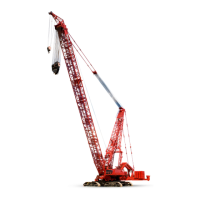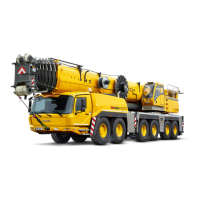Manitowoc Published 10-01-12, Control # 044-05 v2 3-67
777 OPERATOR’S MANUAL OPERATING CONTROLS AND PROCEDURES
3
PREPARATION FOR COLD WEATHER
Crane Limitations
The static load carrying limitations of the steels used in
Manitowoc cranes is not affected by cold weather.
Manitowoc’s capacity charts are acceptable for use in cold
weather.
Dynamic loads (impact and shock) can affect the steels used
in Manitowoc cranes when operating in cold weather.
Dynamic loads are created by traveling, sudden application
and release of load, and duty-cycle operations.
To prevent possible damage to the crane and its attachment
when operating during cold weather Manitowoc
recommends:
• At -5 to -22°F (-21 to -30°C) — Avoid impact or shock
loading of crane and attachment. Operations involving
hydraulic cranes should be conducted with regard to
potential failure of hydraulic components.
• At -23 to -40°F (-31 to -40°C) — De-rate crane by 40%
for all lift operations. Halting all lifts should be
considered. Duty-cycle operation is prohibited.
• Below -40°F (-40°C) — All operation (lift and duty-cycle)
is prohibited except in extreme emergencies, and then
only with approval from a competent engineer who has
de-rated the crane accordingly.
Wire Rope
Wire rope manufacturers indicate that wire rope will not
become brittle in temperatures down to -30°F (-34°C).
Lubrication may be a problem during extreme cold weather
as normal wire rope lubricants may harden and chip off
leaving the rope without lubrication.
Consult your wire rope supplier for recommended cold–
weather lubricants.
Cold Weather Starting Aid
Engine startup at temperatures below 40°F (4°C) requires
the use of a cold weather starting aid.
Coolant and Oil Pan Heaters
A 120 volt coolant and oil pan heater can be installed in the
engine. The heaters use an electric heating element to heat
the coolant and oil inside the engine when the crane is idle.
Each heater has an extension cord for connecting to an
owner furnished electric power supply. The coolant heater
must be capable of maintaining the engine’s coolant and oil
temperatures between 40 to 50°F (4 to 10°C). Contact the
nearest engine distributor for availability and installation of
the heaters.
Engine heaters must be unplugged when engine is
running to prevent cooling system from overheating.
Cooling System
The cooling system must be kept full and be protected from
freezing at the lowest expected ambient temperature. See
the engine manual for antifreeze recommendations.
A mixture of 40% antifreeze and 60% water provides freeze
protection to -35°F (-37°C). A mixture of 60% antifreeze and
40% water provides freeze protection to approximately -60°F
(-51°C). 100% antifreeze will freeze at -10°F (-23°C).
Battery
To provide maximum cranking power and to prevent the
battery from freezing, it must be kept fully charged (1.26
to1.28 specific gravity) and warm when the crane is idle
during cold weather.
It is recommended that the battery be stored indoors or
heated with a battery heater when the crane is idle.
Be aware that:
• A battery with a 50% charge freezes at -16°F (-27°C). A
battery with a 100% charge freezes at -70°F (-57°C).
• A battery with a 100% charge retains only 40% of its
cranking power at 0°F (-18°C). At -20°F (-29°C), the
same battery retains only 18% of its cranking power.
Engine Oil
See engine manufacturer’s manual for recommendations.
Fuel Oil
See engine manufacturer’s manual for recommendations.
Gear Oil
Hydraulic Cranes
Use a gear oil which meets MIL-L-2105C specification or
API-GL-5 classification. Change to one of the following
viscosities when the corresponding temperature range will
be encountered:
• 75W-90 below: -10°F (-23°C).
DANGER
Engine Explosion Hazard!
The crane engine has an air intake pre-heater, do not
spray any combustible starting aid (ether) into air intake.
Pre-heater will ignite ether causing a severe explosion
and/or burns.

